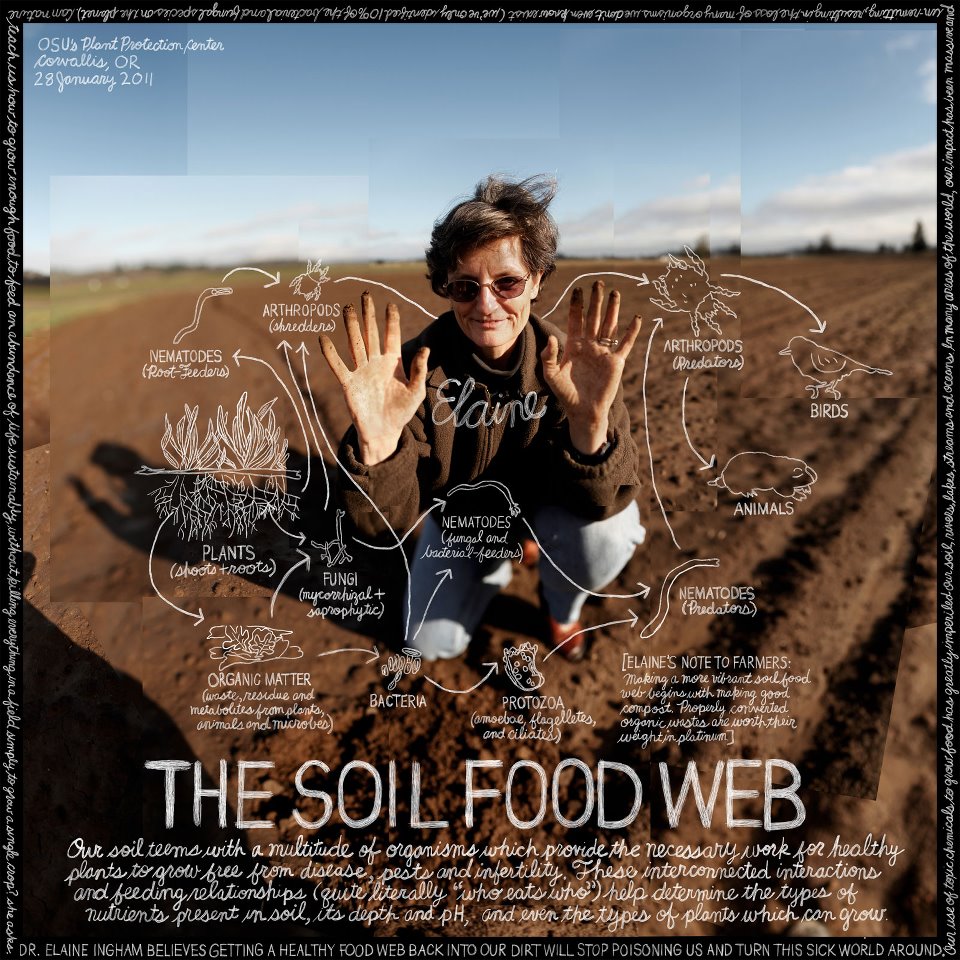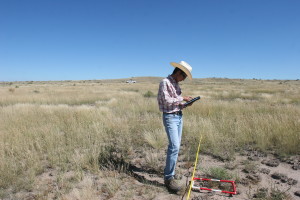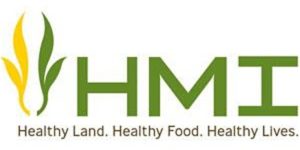A new PBS documentary, “The First Millimeter: Healing the Earth,” explains why the first millimeter of soil is critical to our collective future. Several Holistic Management practitioners from around the world share the practices they use to build healthy soils and vibrant communities.
Talking Dirty: soil health workshop Mar. 20-21
If you consider yourself a gardener, farmer, rancher or landscape architect, think again.
“Instead, you are a soil manager,” says Dr. Elaine Ingham, who will be giving a workshop and free lecture on soil health March 20-21 at Cedar Valley College in Lancaster.
Ingham is a leading soil microbiologist, composting guru, and former chief scientist of the organic-farming icon, The Rodale Institute. Whether your soil is growing tomatoes in an urban backyard or cattle forage in a pasture, Ingham offers practical knowledge about how to make soils and plants flourish without synthetic chemicals.
The free lecture on Friday, “Talking Dirty Soil Solutions,” provides an introduction to the soil food web—the complex system of microorganisms that create and sustain healthy, fertile soil. The lecture will be held in the Cedar Valley College gym from 9am to 10am.
A full-day workshop on Saturday delves deeper into the soil food web, compost, and compost tea technology. Ingham will explain the elements of a thriving soil food web, teach participants how to analyze and improve soil, and demonstrate how to make composts and organic extracts to strengthen the soil food web. This workshop costs $99 and will be held from 9am to 5pm in Cedar Valley College rooms M121-M122.
Ingham will share more of her wisdom during a benefit dinner on Thursday, March 19, at the Farm Girls’ Waxahachie classroom. Live music by Justin Smith and a farm-to-table banquet prepared by Chef Amy, co-owner of Field to Meal, will raise funds to provide free workshop passes for agricultural producers. The festivities start at 7pm and the requested donation is $65 to $150. To reserve a spot at the banquet, visit https://www.eventbrite.com/e/farm-to-fork-dinner-benefitting-farmers-tickets-15826384141
For more information, to register, or to nominate a producer for a free workshop pass, visit carboneconomyseries.com or call (469) 554-9202. The lecture and workshop are presented by the Carbon Economy Series, in partnership with the Dixon Water Foundation.

Soil Health Conference in Fort Worth on Jan. 13 & 14
Green Cover Seed will be hosting the Southern Soil Health Conference, an Educational Opportunity for Producers and Land Owners, in Fort Worth on January 13 and 14, 2015.
The Dixon Water Foundation is one of several organizations sponsoring the conference: Samuel Roberts Noble Foundation, Texas Grazing Land Conservation Initiative, No-Till on the Plains, Sand County Foundation, Out On The Land, and Natural Resources Defense Council.
This unique conference will focus solely on the Five Keys to Soil Health: Keep the Soil Covered; Minimize Soil Disturbance; Crop Diversity; Living Roots in Soil at all times; and Integration of Livestock with the Land. This conference is for producers and land owners, 75% of the registration slots will be reserved for people directly involved with the land: production agriculture (crops and/or livestock) and land owners. This conference will also be producer driven with almost all the speakers and presenters being farmers. Keynote speakers will include; Gabe Brown, Scott Ravenkamp, Robin and Kelly Griffeth, and Paul Jasa. In addition, we will have 8-10 Texas and Oklahoma producers sharing about their individual experiences with Soil Health and how it has affected their farming operations. Some of these speakers are Todd Kimbrell, Terry McAllister, Jonathan Cobb,and Lisa Bellows. And this conference is about knowledge and learning and not selling products. We will not be having a commercial trade show to promote individual companies or products.
To register or learn more, visit Green Cover Seed’s conference website.
Location:
Best Western Plus South
100 Altamesa Boulevard E
Fort Worth, Texas, 76134
Phone: 817.293.3088
Date: January 13th & 14th, 2015
Cost: $100 Per Person – Your Spouse can register for $50**
*NOTICE – The cost of registration DOES NOT reserve your hotel room. You must book and cover the cost of your hotel room on your own. To reserve your room at the Best Western Plus, contact the hotel (information listed above) and be sure and mention Southern Soil Health Conference when you are booking your room to get the discounted rate of $69 per night.
Dixon-funded research on soil microbes featured in Texas Wildlife magazine and Big Bend Sentinel
How did the Rock House Fire and 2011 drought affect soil microbes at Mimms Unit? That was the subject of a recent research project by Masahiro Ohnishi, a Natural Resource Management graduate student at Sul Ross State University in Alpine. The Dixon Water Foundation funded Ohnishi’s research, which was featured in “The Road to Recovery” in the July 2013 issue of Texas Wildlife, republished here with permission of the Texas Wildlife Association. Ohnishi’s research was featured previously in the May 16, 2013 issue of the Big Bend Sentinel.
Soil still teems with life after fire, SRSU student finds
MARFA – Two years ago, the Rock House Fire and a record drought scorched most of the Dixon Water Foundation’s Mimms Ranch outside Marfa. The effects aboveground are still obvious, where grasslands are punctuated by patches of barren earth. But how did the fire and drought affect microbes toiling in the soil to create the nutrients grasslands require? This subterranean recovery was studied recently by Masahiro Ohnishi, a Natural Resource Management graduate student at Sul Ross State University in Alpine.
“We wanted to see what kinds of bacteria and archaea are in the soil after the fire and after the drought, and how they recovered from these huge disturbances,” says Ohnishi, whose research was funded by the Dixon Water Foundation, a non-profit that promotes healthy watersheds through sustainable land management.
Bacteria and archaea are single-celled microscopic organisms that are found practically everywhere—from deep-sea vents and arctic glaciers, to cattle intestines and human belly buttons. Many microbes belong to nature’s recycling crew; they break down dead plants and convert them into nutrients required by living plants. Microbes also help create a complex soil texture, which in turn allows seeds to take hold and more rainwater to soak into the ground. All of these functions make soil microbes essential members of a desert grassland ecosystem.
To determine which microbes populate Mimms Ranch, Ohnishi analyzed the microbial DNA in soil samples collected from several unburned, burned and intensely overgrazed sites. Then he used statistical analyses to compare these microbial communities before and after the summer rainy season in 2012. He also looked for correlations with the amount of plant cover, soil nutrients, and other soil characteristics at each study site.
In burned areas, Ohnishi found nearly half as much microbial DNA as in unburned areas, indicating soil microbes had been hit hard by the fire and drought. But microbial activity recovered after the summer rainy season at both burned and unburned sites. Ohnishi observed a corresponding increase in the amount of certain soil nutrients needed by grasses and other plants, which also bounced back after the summer rains.
Ohnishi was particularly amazed by the diversity of soil microbes he encountered. For example, one five-gram soil sample—the weight of a nickel—was home to around 400 types of bacteria.
“There’s so much diversity, and these microbes perform so many functions,” he said. “We have no clue what they all do yet.”
Understanding what each soil microbe does will be up to future researchers. For now, Ohnishi’s research demonstrates that these microbes are part of the recovery process after a devastating fire and drought. And he envisions his research contributing to a micro-ecosystem approach to land management, in which supporting microbial activity would be a way to improve rangeland health.
Bonnie Warnock, associate professor of range science at Sul Ross State University, directed Ohnishi’s research.
“Both the physical and biological health of the soil is critical to healthy ecosystems,” she said. “We tend to take the soil for granted and forget that it is, in a very real way, the base for all life.”



